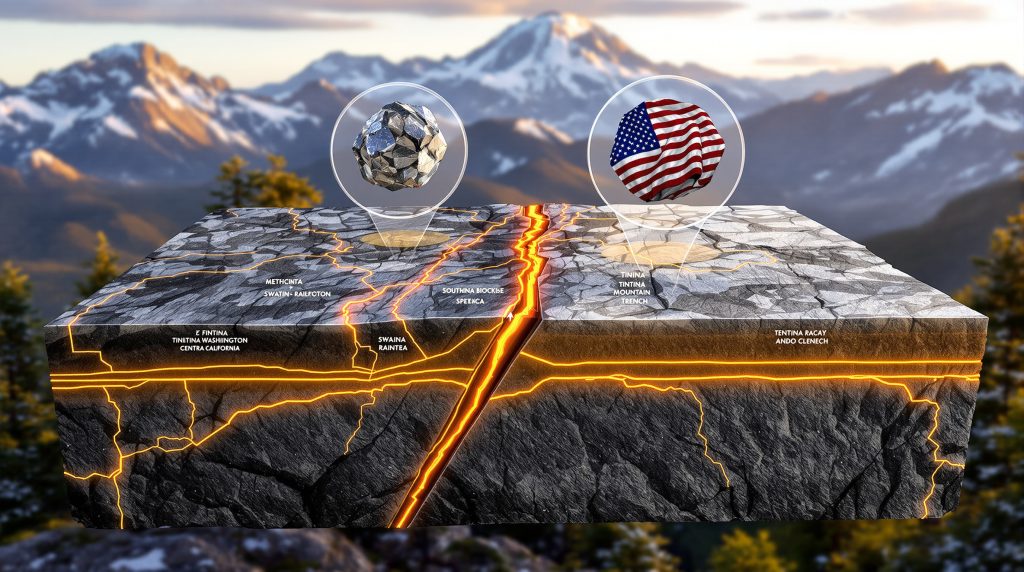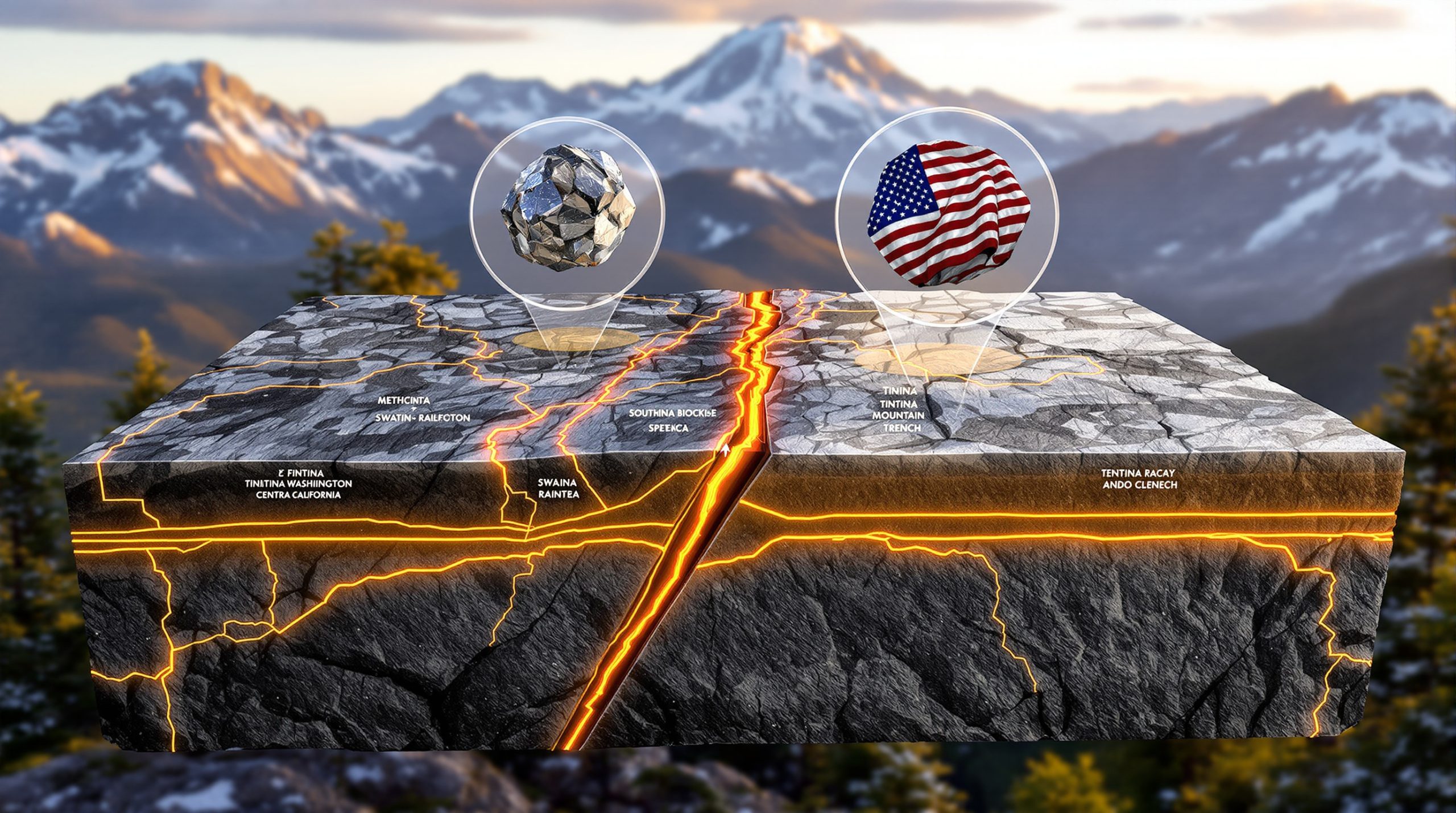What is the Swain Biotite Gneiss and Why Does it Matter?
The Swain Biotite Gneiss represents a fascinating metamorphic formation with outsized geological importance despite its limited geographic footprint. Located in central Washington near Wenatchee, this distinctive rock unit serves as a crucial puzzle piece for understanding the complex tectonic processes that have shaped western North America over millions of years.
This metamorphic rock exhibits a characteristic "salt-and-pepper" appearance, with sparkling black biotite minerals distributed throughout a weakly foliated matrix. Though unassuming at first glance, its geological significance extends far beyond its modest surface exposures.
Key Characteristics of the Swain Biotite Gneiss
The Swain Biotite Gneiss possesses several distinctive features that make it recognizable to geologists:
- Originally formed as arkosic sandstone approximately 80 million years ago
- Transformed into metamorphic gneiss around 72 million years ago
- Required burial depths exceeding 20 kilometers to achieve metamorphism
- Displays weak foliation patterns indicative of its deformation history
- Features a characteristic sparkly appearance due to biotite content
- Limited geographic distribution in a triangular area of central Washington
The seemingly limited distribution of this rock unit belies its profound importance in regional geological studies. According to geological research on North Cascades formations, the Swain Biotite Gneiss represents one of the most significant pieces of evidence for understanding large-scale continental tectonics in western North America.
How Did the Swain Biotite Gneiss Form?
The Sedimentary Origin Story
The geological journey of the Swain Biotite Gneiss began in the Late Cretaceous period, approximately 80 million years ago. Detailed mineralogical and mining economics analyses reveal that this metamorphic formation originated as arkosic sandstone deposits belonging to the Nanaimo Formation.
Interestingly, the unmetamorphosed equivalent of these sandstones can still be observed today on Vancouver Island and the Gulf Islands in British Columbia, providing a rare opportunity to directly compare the original sedimentary material with its metamorphosed counterpart. Detrital zircon studies and chemical signatures confirm this connection, establishing a clear genetic link between the sandstones to the north and the gneiss in Washington.
The Metamorphic Transformation Process
Around 72 million years ago, these sedimentary layers underwent dramatic transformation through a process involving extreme heat and pressure. The metamorphic history includes:
- Burial to depths exceeding 20 kilometers within Earth's crust
- Exposure to temperatures likely exceeding 500°C during peak metamorphism
- Compression under immense lithostatic pressure during tectonic convergence
- Mineral recrystallization while preserving aspects of the original sedimentary composition
- Development of weak foliation patterns reflecting the stress field during metamorphism
- Eventual uplift and exhumation through later tectonic processes
This metamorphic transition required specific tectonic conditions capable of burying sedimentary rocks to mid-crustal depths—conditions that provide crucial clues about the regional tectonic environment during the Late Cretaceous period.
Where Can the Swain Biotite Gneiss Be Found?
Geographic Distribution in Washington
The surface exposures of the Swain Biotite Gneiss occupy a relatively small triangular area in central Washington state, bounded by:
- Wenatchee to the south
- Entiat to the north
- Leavenworth to the west
This limited surface distribution makes the formation relatively easy to miss, despite its geological importance. The exposed outcrops show characteristic weathering patterns, with fresh surfaces revealing the distinctive sparkly appearance but weathered surfaces displaying a more corroded, dull exterior.
Subsurface Extent and Related Formations
Though surface exposures are limited, geological investigations suggest the Swain Biotite Gneiss extends much further beneath younger geological formations:
- Continues eastward beneath Columbia River Basalt flows (16 million years old)
- Exists at depth beneath the Chum Stick Basin and its Eocene sandstone deposits
- Forms part of the basement rock structure beneath portions of central Washington
- May connect to similar metamorphic units throughout the region
It's important to distinguish the Swain Biotite Gneiss from the younger Chumstick arkosic sandstone (Eocene, younger than 50 million years) visible along US Highway 2 between Wenatchee and Leavenworth. Despite some similarities in composition, these formations represent entirely different geological episodes separated by over 20 million years.
What Makes the Swain Biotite Gneiss Geologically Significant?
Connection to the North Cascades Complex
The Swain Biotite Gneiss represents an important component of the North Cascades geological province, which consists predominantly of:
- Oceanic and exotic terranes accreted to the North American continent
- Multiple generations of plutonic intrusions cutting through metamorphic basement
- Metamorphic rocks with complex deformational histories spanning millions of years
- Evidence of major crustal-scale fault systems affecting regional tectonics
Recent research focused on the North Cascades has identified three distinct generations of magmatic plutons intruding the metamorphic rocks in the region, including those similar to the Swain Biotite Gneiss. These intrusive relationships provide crucial age constraints and information about the regional tectonic evolution.
Relationship to the Coast Plutonic Complex
When considering the effects of the Straight Creek Fault and restoring displaced rock units to their pre-fault positions, the Swain Biotite Gneiss can be linked to the extensive Coast Plutonic Complex, which extends from:
- Central Washington
- Through British Columbia
- Into southeastern Alaska
This connection places the seemingly isolated Swain Biotite Gneiss within a much larger geological framework spanning thousands of kilometers. Recognizing this relationship transforms our understanding of this local rock unit, repositioning it as the southernmost extension of one of North America's largest and most significant batholithic complexes.
How Does the Swain Biotite Gneiss Connect to California?
Matching Metamorphic Units in Southern California
Perhaps the most intriguing aspect of the Swain Biotite Gneiss is its striking similarity to metamorphic formations found in Southern California and Arizona, thousands of kilometers to the south:
| Southern California Unit | Age (Million Years) | Characteristics | Similarity to Swain Gneiss |
|---|---|---|---|
| Pelona Schist | ~80-72 | Metamorphosed arkosic sandstone | Nearly identical protolith and age |
| Orocopia Schist | ~80-72 | Biotite-rich metamorphic unit | Matching mineral assemblages and zircon signatures |
| Rand Schist | ~80-72 | Similar metamorphic grade | Comparable tectonic setting and timing |
The differences in mineral deposit classification between "schist" and "gneiss" primarily reflect slight variations in metamorphic grade and foliation intensity rather than fundamental differences in origin. Both the Swain Biotite Gneiss and these southern schist units share remarkably similar protoliths, ages, and metamorphic histories despite their current geographic separation.
Evidence for Long-Distance Tectonic Transport
The striking similarities between the Swain Biotite Gneiss and Southern California schists provide compelling evidence for:
- Large-scale crustal movement along the western margin of North America
- Hundreds to thousands of kilometers of northward displacement of crustal blocks
- Complex fault systems capable of transporting large rock masses over continental distances
- Tectonic processes operating over tens of millions of years
This correlation was first identified approximately 15 years ago, with additional supporting evidence continuing to accumulate. Recent investigations have further strengthened this connection through detailed chemical, mineralogical, and geochronological analyses.
What is the "Baja BC Hypothesis" and How Does it Relate?
The Controversial Tectonic Model
The connection between the Swain Biotite Gneiss and Southern California metamorphic rocks forms a key piece of evidence supporting the controversial "Baja BC" hypothesis. This model proposes:
- Large portions of the western North American margin originated much further south
- Crustal blocks moved northward along major fault systems
- Displacement distances of 1,000+ kilometers occurred since the Late Cretaceous
- The current configuration of western North America resulted from this large-scale crustal transport
This hypothesis remains contentious within the geological community, with vigorous debate ongoing about the magnitude and mechanisms of proposed displacements. However, the growing body of evidence linking geographically distant but geologically similar rock units continues to challenge conventional models of western North American tectonics.
Evidence Supporting the Hypothesis
The Baja BC model is supported by multiple lines of evidence beyond just the Swain-Pelona connection:
- Paleomagnetic data indicating northern displacement
- Matching geological units separated by vast distances
- Similar fossil assemblages in now-distant locations
- Comparable metamorphic and igneous histories across regions
- Structural features consistent with large-scale crustal transport
Critics of the hypothesis point to alternative explanations for these observations, including issues with paleomagnetic data interpretation, the possibility of localized tectonic rotations rather than long-distance transport, and questions about the mechanisms capable of accommodating such large displacements.
How Does the Tintina-Rocky Mountain Trench Fault System Factor In?
The Hidden Fault Solution
Recent research proposes that the enigmatic Tintina-Rocky Mountain Trench fault system may provide a solution to the Baja BC controversy. This major fault system could potentially:
- Accommodate large-scale crustal movement along western North America
- Connect disparate fault segments across thousands of kilometers
- Explain the current distribution of once-adjacent rock units
- Reconcile paleomagnetic data with geological observations
The Tintina-Rocky Mountain Trench represents one of North America's largest fault systems, extending from Alaska through Yukon and British Columbia into the northern United States. Despite its enormous scale, its role in accommodating large-scale crustal movement has been underappreciated in many tectonic reconstructions.
Implications for Western North American Tectonics
This fault system's potential role in the northward transport of crustal blocks has profound implications for understanding:
- The assembly of western North America's geological provinces
- Timing and mechanisms of terrane accretion along the continental margin
- Distribution of mineral resources across the region
- Seismic hazards associated with these major fault systems
- Paleogeographic reconstructions of the North American Cordillera
If correct, this model would require significant revisions to conventional understanding of western North American geological evolution, potentially reshaping fundamental concepts in North American tectonics.
What Does Microscopic Analysis Reveal About the Swain Biotite Gneiss?
Mineral Composition and Metamorphic Grade
Detailed petrographic examination of the Swain Biotite Gneiss reveals:
- Abundant biotite mica giving the rock its characteristic sparkly appearance
- Quartz and feldspar forming the groundmass of the rock
- Accessory minerals indicating specific pressure-temperature conditions
- Textures recording deformation history during metamorphism
- Evidence of the original sedimentary composition preserved despite metamorphism
The mineral assemblage present in the Swain Biotite Gneiss indicates metamorphism under amphibolite facies conditions, consistent with the estimated burial depths exceeding 20 kilometers. This level of metamorphism requires specific tectonic settings capable of generating both the necessary pressure and temperature conditions.
Metamorphic Reactions and Conditions
The mineral assemblages present in the Swain Biotite Gneiss indicate:
- Amphibolite facies metamorphism consistent with mid-crustal depths
- Temperatures likely exceeding 500°C during peak metamorphism
- Pressures corresponding to burial depths of approximately 20 kilometers
- Retrograde reactions during uplift and cooling
- Preservation of prograde metamorphic textures
These conditions provide important constraints on the tectonic models capable of explaining the metamorphic history of the Swain Biotite Gneiss and its correlative units in California. The specific pressure-temperature path experienced by these rocks helps identify the most plausible tectonic scenarios.
How Does the Swain Biotite Gneiss Fit into Regional Geological History?
Late Cretaceous Tectonic Setting
During the Late Cretaceous period when the Swain Biotite Gneiss formed:
- The western margin of North America functioned as an active convergent boundary
- Subduction of oceanic plates generated magmatism and crustal thickening
- Sedimentary basins formed in various tectonic settings along the margin
- Deformation and metamorphism affected rocks at different crustal levels
- Large-scale fault systems began accommodating complex crustal movement
The Late Cretaceous represents a critical period in western North American tectonic evolution, with the formation of the Swain Biotite Gneiss and its correlative units coinciding with major reorganizations of plate boundaries and crustal blocks.
Post-Metamorphic Tectonic Evolution
After its metamorphic transformation, the Swain Biotite Gneiss experienced:
- Uplift and exhumation from mid-crustal depths
- Displacement along major fault systems
- Partial burial beneath younger sedimentary and volcanic deposits
- Exposure through erosion and continued tectonic activity
- Preservation as a key witness to complex crustal processes
The subsequent geological history includes overprinting by younger tectonic events, including burial beneath Eocene sedimentary basins and Miocene flood basalts, further complicating efforts to unravel its complete tectonic history.
What Analytical Techniques Help Understand the Swain Biotite Gneiss?
Modern Geochronological Methods
Understanding the timing of events recorded in the Swain Biotite Gneiss relies on sophisticated dating techniques:
- U-Pb dating of zircon minerals to determine protolith age
- Ar-Ar dating of biotite to constrain metamorphic timing
- Detrital zircon analysis to identify sediment source regions
- Thermochronology to track cooling and uplift history
- Integrated dating approaches to establish a comprehensive timeline
These techniques have revolutionized our ability to constrain the timing of geological events with unprecedented precision, allowing for more detailed correlations between geographically separated rock units.
Geochemical and Isotopic Analysis
Chemical and isotopic signatures provide crucial information about:
- Original sedimentary composition and source areas
- Metamorphic reactions and mineral transformations
- Tectonic setting during formation and metamorphism
- Correlation with other units across western North America
- Paleogeographic reconstruction of crustal blocks
Advanced analytical methods, including rare earth element patterns, radiogenic isotope signatures, and trace element distributions, provide powerful tools for establishing genetic relationships between apparently distinct geological units.
How Does the Swain Biotite Gneiss Challenge Conventional Tectonic Models?
Rethinking Crustal Evolution
The connections revealed by the Swain Biotite Gneiss and related units challenge geologists to:
- Consider larger-scale crustal movements than previously accepted
- Reevaluate the assembly history of western North America
- Integrate diverse datasets into coherent tectonic models
- Recognize the importance of large-scale strike-slip fault systems
- Develop more sophisticated paleogeographic reconstructions
These challenges require geologists to remain open to paradigm-shifting interpretations, even when they conflict with established models of crustal evolution.
Implications for Future Research
These challenges point toward several promising research directions:
- More detailed correlation of metamorphic units across western North America
- Refined geochronology to better constrain timing of events
- Advanced structural analysis of major fault systems
- Integrated tectonic models incorporating diverse geological evidence
- Exploration of similar large-scale crustal transport globally
The ongoing investigation of the Swain Biotite Gneiss and its regional connections highlights the dynamic nature of geological science, where new discoveries and interpretations continue to reshape our understanding of Earth's tectonic evolution.
FAQ: Common Questions About the Swain Biotite Gneiss
What distinguishes gneiss from schist in metamorphic classification?
Gneiss and schist represent different textural classes of metamorphic rocks, primarily distinguished by their foliation characteristics. Gneiss typically displays banding of light and dark minerals with moderate to weak foliation, while schist exhibits strong foliation dominated by aligned platy minerals like mica. The difference often reflects metamorphic grade, with gneiss generally forming at higher temperatures and pressures than schist, though both can derive from similar protoliths.
Why are metamorphic rocks important for understanding tectonic history?
Metamorphic rocks record conditions deep within the Earth that aren't directly observable. Their mineral assemblages, textures, and isotopic compositions preserve evidence of past tectonic processes including:
- Depth of burial (pressure conditions)
- Temperature extremes experienced
- Rates of tectonic processes
- Deformation patterns during mountain building
- Timing of major tectonic events
These records make metamorphic rocks like the Swain Biotite Gneiss invaluable for reconstructing Earth's dynamic history.
How do geologists determine the original rock type before metamorphism?
Geologists use several approaches to identify the protolith (original rock) of metamorphic formations:
- Relict textures preserved despite metamorphism
- Bulk chemical composition compared to known rock types
- Characteristic mineral assemblages indicative of specific protoliths
- Isotopic signatures that persist through metamorphism
- Trace element patterns reflective of original composition
For the Swain Biotite Gneiss, detailed chemical analysis and comparison with the Nanaimo Formation sandstones provide compelling evidence of its sedimentary origin.
What evidence supports the long-distance movement of crustal blocks?
Multiple independent lines of evidence support large-scale crustal transport:
- Paleomagnetic data indicating formation at different latitudes
- Matching distinctive rock units now separated by great distances
- Similar fossil assemblages in now-distant locations
- Structural features consistent with large-scale strike-slip faulting
- Timing constraints from drilling result interpretations and geochronology supporting synchronized events
The correlation between the Swain Biotite Gneiss and Southern California schists represents one of the most compelling examples of this evidence.
Further Exploration
The study of the Swain Biotite Gneiss and its regional connections remains an active area of geological research, with new analytical techniques and field observations continually refining our understanding of western North American tectonics. The ongoing debate surrounding large-scale crustal transport and the role of major fault systems demonstrates the dynamic nature of geological science, where even fundamental assumptions about supercontinent cycles in geology remain subject to revision as new evidence emerges.
For those interested in exploring these concepts further, the outcrops near Wenatchee offer a tangible connection to these fascinating geological processes. By examining this unassuming metamorphic rock, observers can gain mineral exploration insights into continental-scale tectonic processes that have shaped western North America over tens of millions of years.
Want to Catch the Next Major Mineral Discovery Before the Market?
Discovery Alert's proprietary Discovery IQ model delivers real-time notifications on significant ASX mineral discoveries, instantly empowering subscribers to identify actionable opportunities ahead of the broader market. Understand why historic discoveries can generate substantial returns by visiting Discovery Alert's dedicated discoveries page and begin your 30-day free trial today to position yourself ahead of the market.




